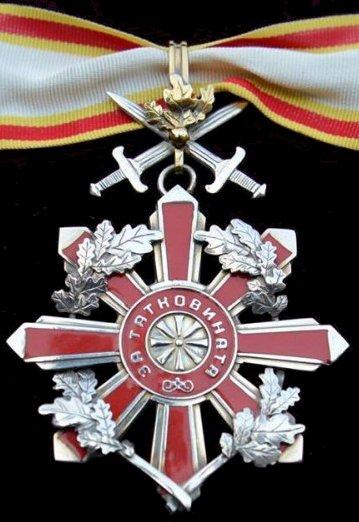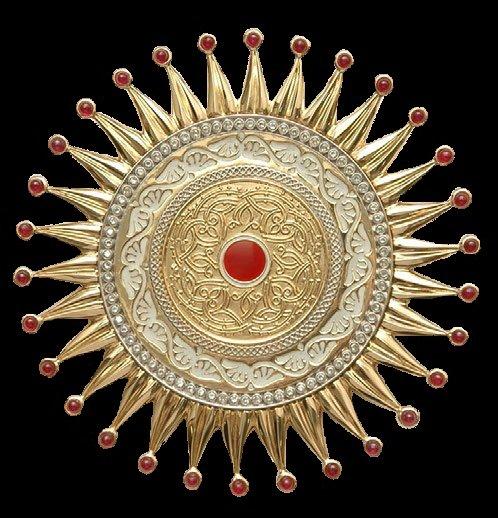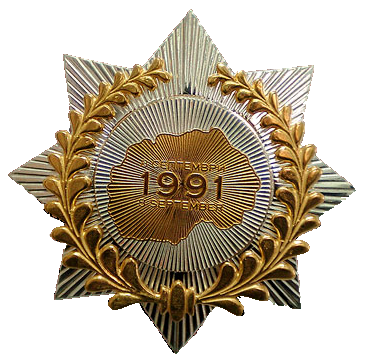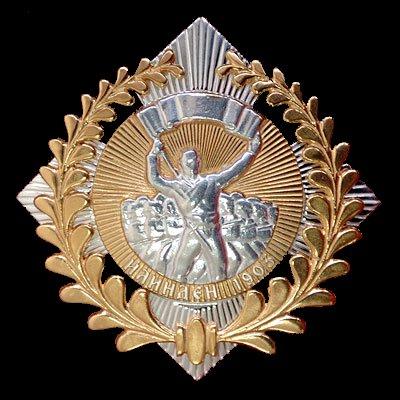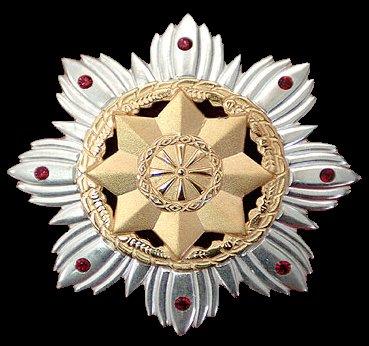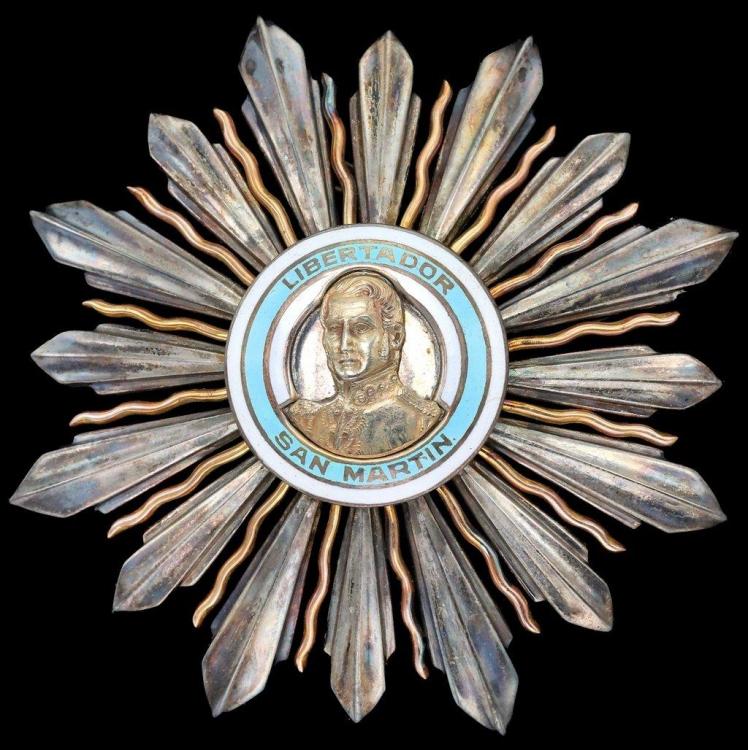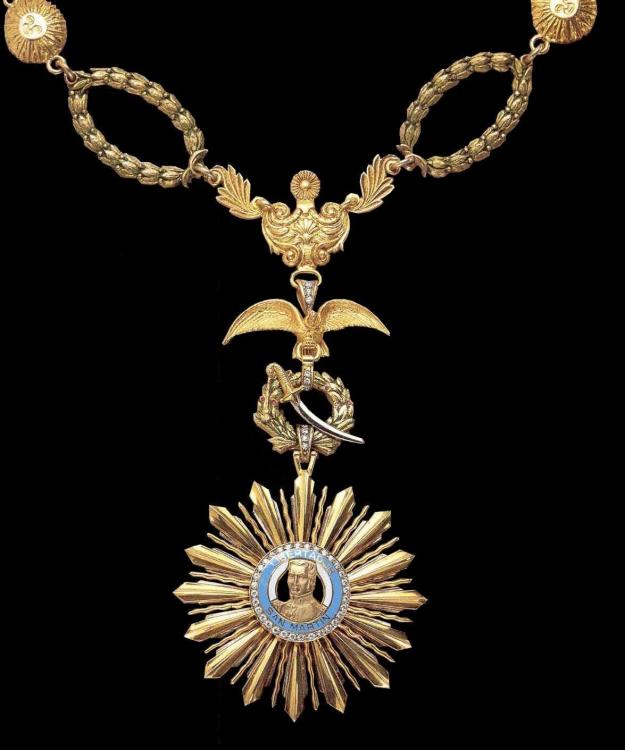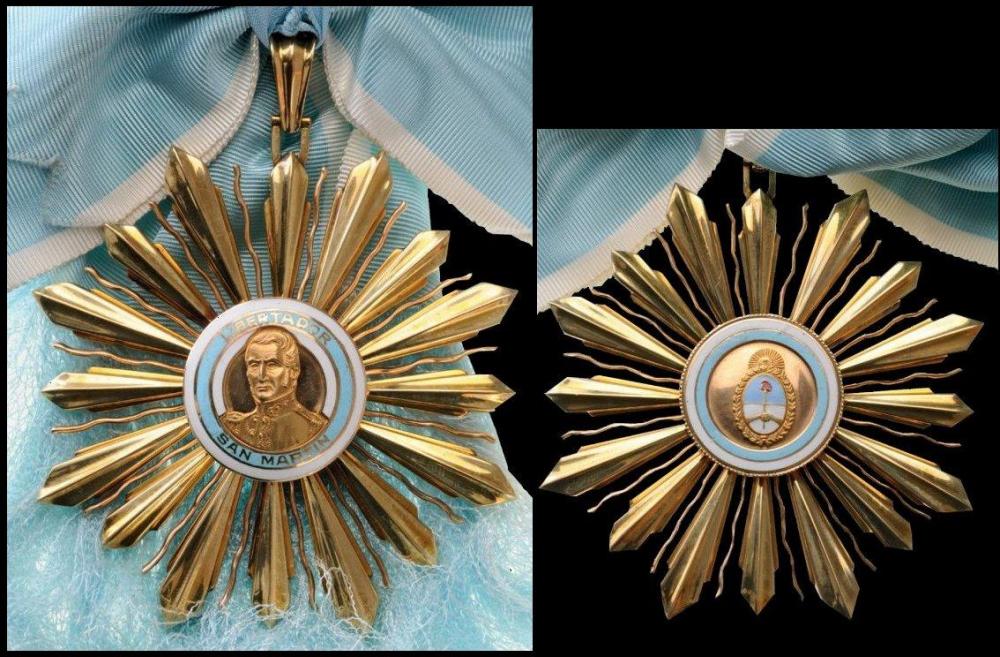-
Posts
3,944 -
Joined
-
Last visited
-
Days Won
32
Content Type
Profiles
Forums
Blogs
Gallery
Events
Store
Everything posted by Megan
-
Continuing, here is the Order of Military Merit (Орден за воени заслуги) which was also instituted on 27 June 2002, this order is awarded for exceptional merit in national defence and security to individuals or institutions. It may also be awarded to police officers and foreigners for services promoting the defence of the Republic, or in strengthening international collaboration between armed forces or police services. Worn on a neck ribbon – white with yellow-edged white edges – the badge takes the form of an eight-pointed gilded silver star, 66mm in diameter, with red-enamelled arms converging on a disk of 12mm diameter with the motto за татковината (FOR THE MOTHERLAND) around a representation of the Macedonian flag. A wreath of silver oak leaves is wound around the arms of the star, and the suspension is comprised of crossed silver swords and gilded oak leaves. The badge was designed by Darko Fidanoski. Thank you Antonio and Emmanuel for your contributions to this thread. I found the Avers catalogue and the regulations Antonio mentioned, although I'm struggling to translate them! There's also an active Macedonian Heraldry Society, who have written in their journal about the Orders I've presented above (they also talk about heraldry and badges, and mercifully publish bilingually in Macedonian and English!). Emmanuel, the badge you show us is interesting as it appears to be all one colour whereas regulations and official pictures suggest that the Order 8th September is silver and gold plate. There are a couple of medals to come... then I need to start figuring out the other stuff in the regulations, with some military awards which appear to be non-wearable plaques with ribbons to wear in uniform, and long service awards. Does anyone here speak Macedonian?
-
Established on 8 September 1991, with a name that's been disputed from the outset by Greece, who understandibly would prefer that there is no confusion between the Republic and their own region called Macedonia, it was originally called the Republic of Macedonia (Former Republic of Yugoslavia), but in January 2019, a compromise title of Republic of North Macedonia was agreed with the Greek parliament (plenty of protests, however, by those who objected to the use of the name Macedonia at all...). But we won't go into that: let's look at some of their orders, decorations and medals instead. Order of the Republic of Macedonia Instituted in 2002, this is the highest state decoration of the Republic of North Macedonia. It is awarded for outstanding services in promoting the sovereignty of Macedonia, developing international relations or other services to the nation. It is a single-class order, consisting of a collar with a badge and a star. The ribbon (worn when ribbons alone are worn) is red with narrow edge stripes. The collar of the order consists of alternate links of the Macedonian flag and a decorative piece based on a mediaeval manuscript. The badge is suspended from a stylised Gordian knot, and is circular, 57mm in diameter. There is a ruby in the centre and a decoration of floral elements and stylised palm trees, with brilliants around the edge. The star of the order has rays of stylised tobacco leaves with a ruby at the end of each ray. There is also a ruby in the centre, surrounded by floral elements and stylised palm trees, and a circle of brilliants (this central part is the same as the badge of the order). Including the rays, the diameter of the star is 91mm. Order of 8th September This order, the second-highest award of the Republic of North Macedonia, was instituted in 2002. It is awarded for exceptional merit in developing relations with other nations, or services to security or defence of the nation. The name of the order is because the republic was founded on 8th September 1991. The badge is an 8-pointed silver star with a diameter of 81mm. In the centre is a gold-plated map of the country with the date 8 September 1991, all surrounded by a gold-plated wreath. The ribbon, worn when ribbons only are worn, is red with yellow-edged white edges. Order of Illlinden 1903 This order is named in honor of the Ilinden Uprising that took place in 1903. Instituted in 2002, it is awarded for merit in the struggle for the national and social liberation, for outstanding contribution to the national legal and social development and strengthening the community relations in the country. The badge of the order is based on a redesign of the Ilinden memorial by Kostadin Tančev-Dinka and Vladimir Borojevik. It consists of a four-pointed silver star, 71mm in diameter. In the centre, on a disk of gold-plated rays, the Ilinden memorial is depicted in silver with Илинден 1903 below, all surrounded by a gold-plated wreath. The ribbon, worn when ribbons only are worn, is red with a yellow central stripe and yellow-edged white edges. Order of Merit of the Republic of Macedonia Instituted in 2002, this order is awarded for contributions to the political, social and cultural life of the country. It is Macedonia's fourth-highest order. The badge of the order is an eight-pointed rayed silver star, 65mm in diameter. There is a small ruby on each arm of the star. In the centre there is a plain gold-plated 8-pointed star with a relief representation of the standard of Macedonia. The ribbon, for when ribbons only are worn, is ed with a white central stripe and yellow-edged white edges That's all for now, but there will be more to follow!
-

How to split US ribbons among the several branches?
Megan replied to Wessel Gordon's topic in United States of America
You might find Lukasz Gaszewski's excellent rackbuilder of assistance: https://medals.pl/us/ The OMSA images collection has separate medal listings for each of the US services as well. -

Today's Knights - Orders of Romania
Megan replied to Blitz's topic in Central & Eastern European States
As one of Antti's proofreaders, all I am going to say is that it's looking good! -
What an ideal posting for you Antonio :)
-
Welcome back!!!!
-
Fairly old and with mostly lineart of the medals discussed: Monick, S. (1988) South African Military Awards 1912-1987, South African National Museum of Military History. The odd copy can be aqcuired via Amazon and other online used book sellers. You can find quite a few links from https://www.medals.org.uk/south-africa/south-africa-links.htm.. and look at the medal list itself there, of course.
-
I have just heard that the Danish Ministry of Justice has announced 4 new medals: 1. The Ministry of Justice Medal 2. The Ministry of Justice Medal for Killed in Action 3. The Ministry of Justice Medal for Wounded in Action 4. The Ministry of Justice Medal for International Service These have been approved by the Queen, but as yet no information on designs of medals or ribbons. As the police long service medal is one of the few Danish ones not to have a red and white ribbon, there's speculation that these new medals may also incorporate the colour green in the ribbon. The Ministry of Justice has oversight of the police and the prisons service, for which the last 3 medals are intended. The first one may be awarded to anyone as the Minister of Justice sees fit. Here is the announcement (in Danish): http://www.justitsministeriet.dk/nyt-og-presse/pressemeddelelser/2019/justitsministeren-kan-nu-haedre-medarbejdere-med-medaljer
-
As I understand it (being neither a lawyer nor an American), as long as you don't try to sell your Medals of Honor in the USA you should be OK. Probably best not to sell to an American citizen even elsewhere. I've been twice asked to facilitate sales by European citizens of the MoH. One was sold to another European, the other went to a museum in America, who went to great lenths to provide proof that they WERE a genuine museum and thus entitled to purchase and display an MoH.
-
There have been some fine images of the new Thai king wearing uniform and medals during his coronation. This one, courtesy of the BBC, is exceptionally fine. Collar and sash are the Order of the Royal House of Chakri. Medals are Order of Chula Chom Klao, Bravery Medal, Freeman Safeguarding Medal, Border Service Medal, Long Service Medal, King Bhumibol Adulyade's Royal Cypher Medal & something at the end I cannot quite make out. Nice view of Thai parachute wings for the badge enthusiasts, too!
-
-
Nations that hold coronations and award 'conronation medals' generally hand them out to those who attend or assist with the coronation. Visiting royals qualify under the first, and troops often get an extra gong under the second, as what's a coronation without a good military parade?
-

Black ribbon bar for Tito's funeral (?)
Megan replied to BalkanCollector's topic in Southern European & Balkan States
I have never heard of any case of a 'mourning ribbon'' - state morning is indicated by a black armband on the left sleeve. Personal mourning when in uniform is indicated by covering a button (think it's the 2nd one from the top) with black cloth. The Norwegian and Swedish royal families are given to medals to mark personal rather than state milestones - but the only black ribboned example I can think of was Sweden's King Gustav V, for whom a Memorial Funeral Medal was issued in 1951 for participation in his funeral the previous year. Sweden also has the Royal Order of the Northern Star, which had a black ribbon until 1975 (then they changed to a yellow-edged blue one). Yugoslavia's never had anything with a black ribbon at all. I agree with Paul's assessment... although I smell fish rather than bovine manure :) -
Just as I was wondering what to do with the upcoming weekend...
-
Great stuff, Emmanuel. Yes, I just found out about Eva Peron's special collar as well, but that's the only image I can find of it. Unfortunately it did not survive the military coup in 1955, being taken apart and all the gems sold off. The design was quite different from that in use today – although the badge of the Order was suspended from a laurel wreath with a curved sabre and Andean condor, the centre link of the collar from which it hung depicted the National Coat of Arms with four flags, and the rest of the Collar was made up of the shields of the then fourteen provinces united by a double chain of drums (representing the Tacuarí drum, based on a legend of a young drummer boy at the 1811 battle between Spanish loyalists and revolutionaries) and closing of laurels with a great sun's finale in back.
-
That's interesting, Emmanuel... poking around on a mostly defunct corner of the Argentinan Chancellory website, it appears that the insignia for the Grand Officer class does indeed consist solely of a breast star. Here's the link: https://web.archive.org/web/20120409224548/http://www.cancilleria.gov.ar/portal/cancilleria/condecoraciones/sm_granoficial.html (archived in 2012) Here's one that Spinks are selling in the new year: The star is silver apart from the 'wavy rays' which are 18 karat gold. It's 90mm in diameter, the same size as the Grand Cross star, which is made completely of gold. I have an image of that somewhere as well... I just prefer to post on my own site before here :)
-

Thailand The Most Noble Order of the Crown of Thailand
Megan replied to dedehansen's topic in South East & East Asia
Splendid... if only I could read Thai! -

Photo or picture about Afghan Order of the Supreme Sun?
Megan replied to johnprice's topic in Middle East & Arab States
Plenty... some are on Medals of the World already but there are more to be added. When I'm at my hom computer I can see about uploading some for you... -

ECUADOR ORDEN SAN LORENZO
Megan replied to heusy68's topic in Rest of the World: Militaria & History
Very handsome, Emmanuel - thank you for sharing. -
1. Order of Ushakov - to naval commanders for meritorious service. 2. Medal for Military Valour Class 2 Not sure about the rest yet, will have to dig a bit! Your man was perhaps a Naval Attaché... so a serving naval officer in a diplomatic posting.
-

Field Marshal Garnet Wolseley
Megan replied to filfoster's topic in Great Britain: Orders, Gallantry, Campaign Medals
India General Service Medal 1854-1895. The clasps awarded are listed here: http://medals.org.uk/united-kingdom/united-kingdom031.htm These do include expeditions to Burma... -
Kingdom of Romania: Medal for Military Virture, instituted 13 November 1926. This is the Type 1 (1926-1940) Class 2: Silver Medal with crown described as a civil award for 'navigating personnel'.


